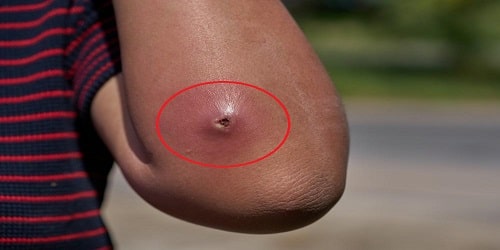Abscess
An abscess is a buildup of pus that can form anywhere on the body. There are many types of abscesses, they can form on the skin, mouth, or around organs.
When the body is exposed to an infection, the immune system works to fight it. White blood cells travel to the infected area and accumulate within the damaged tissue.
This buildup causes inflammation, causing the formation of a pus-filled pocket called an abscess. The pus consists of live and dead white blood cells, germs, fluid, and dead tissue.
Causes of Abscess
When the normal skin barrier is damaged, (even from minor trauma, small tears, or inflammation) bacteria can enter the skin. Abscesses can form because the body’s defenses try to kill these germs with an inflammatory response (white blood cells pus). Obstruction of sweat or oil (sebaceous) glands, or pre-existing hair follicles or cysts can also trigger abscesses.
The center of the abscess liquefies and contains dead cells, bacteria, and other particles. This area begins to grow, creating tension under the skin and further inflammation of the surrounding tissue. Pressure and inflammation cause pain.
Types of Abscesses and Their Causes
There are several types of abscesses. This condition can develop on the skin, mouth or around the person. The most common types of abscesses are:
1. Skin abscess
A skin abscess forms under the skin. This condition is common and usually easy to treat. Skin abscesses are divided into several types, including:
Armpit abscess. Occurs when pus collects in the armpit. One cause is a condition called hidradenitis suppurativa. Hidradenitis suppurativa causes red, tender lumps on the underarm skin, which can turn into abscesses over time.
Breast abscess. This condition occurs when there is a pocket of pus in the breast. The cause is often a breast infection that is not treated immediately. Breast abscesses are common among mothers who are breastfeeding.
Anorectal abscess. This condition is visible under the skin around the anus or rectum. Perianal abscess is a type of anorectal abscess that affects the skin around the anus. Meanwhile, a pilonidal abscess is an abscess in the skin folds of the buttocks.
2. Oral abscess
Oral abscesses can form on the teeth, gums, and throat. There are several types of tooth abscesses, including:
Gingival abscess or gum abscess. This abscess develops in the gums but does not affect the teeth.
Periapical abscess disease. This is an infection that forms at the tip of the tooth root. Periapical abscesses can occur due to tooth injury or cavities.
Periodontal abscess. Conditions that affect the bones and tissues that support the teeth. Usually occurs due to periodontitis or gum disease.
Tonsil abscess. This is the formation of a pocket of pus behind one of the tonsils. Tonsillar abscess is a type of tonsil abscess, which most often occurs in teenagers and young adults.
Peritonsillar abscess. This is a buildup of pus around the tonsils and throat walls.
Retropharyngeal abscess. An abscess forms at the back of the throat. This type of abscess forms when the lymph nodes in the back of the throat become infected.
3. Internal Abscess
Internal abscess is a rare condition. This condition can develop in the spinal cord, brain, and other people. Internal abscesses are usually difficult to diagnose and treat. Several types of internal abscesses, namely:
Stomach abscess. This is a buildup of pus in the stomach. Abdominal abscesses can develop in or near the liver, kidneys, pancreas, or other organs.
Spinal cord abscess. This is a buildup of pus in and around the spinal cord. The cause is an infection in the spine.
Brain abscess. Pus buildup in the brain is a rare condition. A brain abscess can form when bacteria from an infection in another area of the head or bloodstream or from a wound enters the brain.
Abscess Risk Factors
Abscesses can appear on any area of the body. The most common places for abscesses to appear are in the armpit (axilla), the area around the anus and vagina (Bartholin’s gland abscess), the base of the spine (pilonidal abscess), around the teeth (dental abscess), and the groin. Inflammation around the hair follicle can also lead to the formation of an abscess, which is called a boil (furuncle).
Several risk factors for abscesses include:
1. Have a weak immune system.
2. Exposure to a dirty environment.
3. Exposure of people to certain types of skin infections.
4. Poor hygiene.
5. Poor metabolism.
Abscess Symptoms
Symptoms of an abscess depend on where it develops on the body. Signs of a skin abscess may include:
1. Subtle swelling under the skin.
2. Pain and soreness in the affected area.
3. Warmth and redness in the affected area.
4. A visible buildup of white or yellow pus under the skin in the affected area.
5. Fever.
6. Hot and cold body.
Abscesses that develop within organs or in the spaces between organs can be more difficult to identify than skin abscesses. Symptoms can be vague and there may be no obvious external signs.
Symptoms of an internal abscess can also vary depending on the exact location in the body the abscess develops. For example, a liver abscess can cause jaundice (yellowing of the skin and eyes), while an abscess in or near the lungs can cause coughing or shortness of breath.
Common symptoms of an internal abscess may include:
1. Discomfort in the abscess area.
2. High body temperature.
3. Increased sweating.
4. Feeling sick.
5. Hot and cold body.
6. Pain or swelling in the abdomen.
7. Loss of appetite and weight loss.

